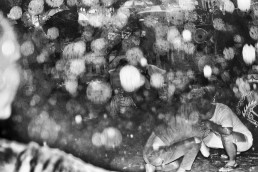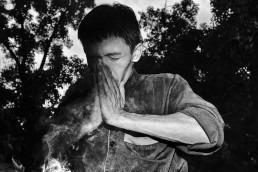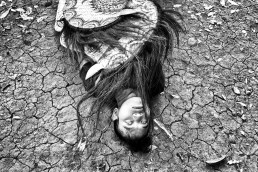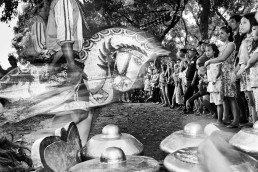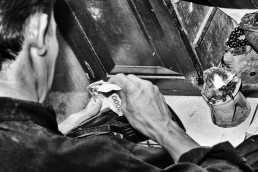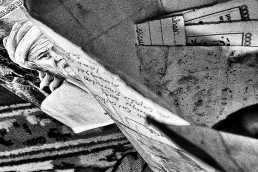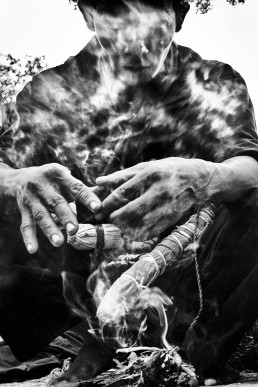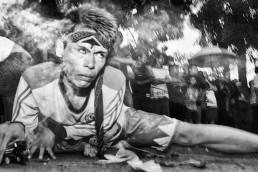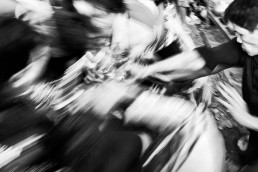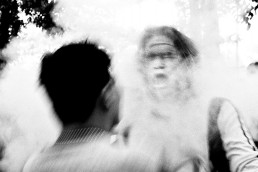The Life of the Shaman’s Spirit
THE LIFE OF THE SHAMAN’S SPIRIT
Galih Pradipta, Media Indonesia
Eling-eling siro manungso, elingono sholat ngaji mumpung durung ketekanan malaikat juru pati, Panggilane Kang Moho Kuoso, gelem ora bakal digowo, diturokno ndek padusan, diadusi banyu kembang, disalini sandhangan putih, yen wes budhal ora biso muleh, tumpakane kereto dowo, rudo papat rupo menungso.
This Javanese song titled “Eling-Eling”—whose lyrics in Javanese mentioned earlier try to warn us that we all will not live forever in this world — sung by a Javanese singer called sinden, accompanied by a gamelan music, is to provide a sign to an “army of horsemen” from Wahyu Kencono Kemayoran art troupe to perform in a middle of an area surrounded by an audience. With a sharp gaze as if they are ready to attack their enemy, the “horsemen” present a dramatic move depicting the spirit to fight possessed by our ancestors in order to defend our country against the colonial power.
A shaman plays a critical role in a performance of jaran kepang/kuda lumping, a traditional Javanese dance depicting a group of horsemen. Chanting prayers and mantras, he establishes a supernatural fence in a square shape. Each corner of the fence functions as a guard assigned to stop any disturbances, launched by any mystical power or others to ruin the performance, from happening. The capability of the shaman or the guide to direct ancestors’ spirit to enter the bodies of the dancers is like directing the troops in a battlefield to defend every inch of land in this place called Nusantara.
Besides being assigned to invite indang, or the ancestor’s spirit, the shaman also prepares the offerings or the food for the invited indang so that the performance may run smoothly.
“Actually, I don’t want to be like this. I got this capability all of the sudden. It requires a great responsibility and a great effort to do. Not something easy at all!” says Kartam (32), one of the founders of Wahyu Kencono Kemayoran art troupe. Before becoming a shaman, Kartam had been introduced to art performance since he was a kid by his father who ran a lengger art troupe in Banyumas.
Then, how could he get a supernatural power to become a shaman?
“I dreamed of being asked and guided by a big and tall old man wearing a turban to fly and then meditate under a waterfall at the top of Putri Hill,” says Kartam, who already possessed a supernatural power when he was 17. Routinely Kartam performed the ancestor’s tradition of various types of fasting such as pasa mutih, pasa patigeni, pasa ngebleng, pasa ngalong, and pasa ngrowot, in addition to performing pilgrimages to a number of ancient cemeteries to meditate in order to maintain his supernatural power.
In a period of more than 10 years, he has skillfully led jaran kepang performances. He often aligns the balance and stability of the performance as a form of communication between the audience and the sub-conscious world. The indang is invited to represent a part of the society who still respect the ancestors.
Jaran kepang is a form of art that has long been around and developed in many parts of the Island of Java as a ritual dance to call the ancestors’ spirits to provide a security protection to a village and a successful harvest. This dance symbolizes power, obedience, and the labor class’ willingness to serve.
Unfortunately, this art form with a supernatural and magic element has been gradually diminished by the ongoing development of thought and culture of modern humans. In fact jaran kepang was once used as medium for an Islamic propagation in the 14th century.

